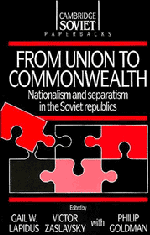Book contents
- Frontmatter
- Contents
- Notes on the contributors
- Preface
- Glossary
- Map: the Soviet Successor States
- 1 Introduction: Soviet federalism – its origins, evolution, and demise
- 2 State, civil society, and ethnic cultural consolidation in the USSR – roots of the national question
- 3 From democratization to disintegration: the impact of perestroika on the national question
- 4 The evolution of separatism in Soviet society under Gorbachev
- 5 Perestroika and the ethnic consciousness of Russians
- 6 Nationality policies in the period of perestroika: some comments from a political actor
- Index
5 - Perestroika and the ethnic consciousness of Russians
Published online by Cambridge University Press: 03 May 2011
- Frontmatter
- Contents
- Notes on the contributors
- Preface
- Glossary
- Map: the Soviet Successor States
- 1 Introduction: Soviet federalism – its origins, evolution, and demise
- 2 State, civil society, and ethnic cultural consolidation in the USSR – roots of the national question
- 3 From democratization to disintegration: the impact of perestroika on the national question
- 4 The evolution of separatism in Soviet society under Gorbachev
- 5 Perestroika and the ethnic consciousness of Russians
- 6 Nationality policies in the period of perestroika: some comments from a political actor
- Index
Summary
The years of perestroika completely undermined the theory of the merging (sliianie) of nations in the Soviet Union. The theory of the ‘melting pot’ in the USA has also not withstood the test of time. Ethnic communities are increasingly making their demands, their interests, and their readiness to act in the name of these interests known throughout the world, and especially in the Soviet Union. Such interests were not only evident before the abortive coup attempt in August 1991, but had a direct impact on both the resolution and the consequences of the crisis.
The modern day articulation of demands by communities which are distinguishable by the size of their population, by their history, the type of territorial distribution, and their governmental and social status necessitates a critical reconsideration of our understanding of the word “nation.” There has been an ongoing dispute among Soviet scholars over the utility of applying the concepts of “nation” and “nationality” to various ethnic groups. In the Platform on Nationality Relations adopted by the Central Committee of the Communist Party in September 1989, both terms were employed. Yet among Soviet ethnographers, especially after discussions during 1987–1989 with the British anthropologist Ernest Gellner, the notion that national ethnoses are communities which possess common ideas, values, and interests – that is, the characteristics of ethnic consciousness – became increasingly popular.
- Type
- Chapter
- Information
- From Union to CommonwealthNationalism and Separatism in the Soviet Republics, pp. 98 - 113Publisher: Cambridge University PressPrint publication year: 1992
- 2
- Cited by



